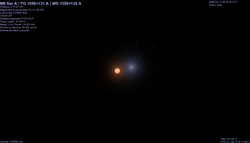NN Serpentis
 Rendering of NN Serpentis system | |
| Observation data Epoch {{{epoch}}} Equinox | |
|---|---|
| Constellation | Serpens |
| Right ascension | 15h 52m 56.2s |
| Declination | +12° 54′ 47.2″ |
| Apparent magnitude (V) | +16.6 |
| Characteristics | |
| Spectral type | DAO1 / M4V |
| Details | |
| Mass | 0.535/0.111 [1] M☉ |
| Radius | 0.0211/0.154 [1] R☉ |
| Luminosity | 4.2/0.00172? [1] L☉ |
| Temperature | 57000/3000? [1] K |
| Orbit | |
| Period (P) | 0.000356[1] yr |
| Semi-major axis (a) | 0.00397884 AU[1]" |
| Eccentricity (e) | 0.0 |
| Inclination (i) | 89.6[1]° |
| Other designations | |
NN Serpentis, NN Ser, PG 1550+131, WD 1550+130 | |
| Database references | |
| SIMBAD | data |
NN Serpentis (abbreviated NN Ser) is an eclipsing post-common envelope binary system approximately 1670 light-years away.[1] The system comprises an eclipsing white dwarf and red dwarf. The two stars orbit each other every 0.13 days.[1]
Planetary system
A planetary system has been inferred to exist around NN Ser by several teams. All of these teams rely on the fact that Earth sits in the same plane as the NN Serpentis binary star system, so humans can see the larger red dwarf eclipse the white dwarf every 0.13 days. Astronomers are then able to use these frequent eclipses to spot a pattern of small but significant irregularities in the orbit of stars, which could be attributed to the presence and gravitational influence of circumbinary planets.
Chen (2009) used these "eclipse timing variations" to suggesting a putative orbital period spanning between 30 and 285 years and a minimum mass between 0.0043 and 0.18 Solar masses.[2]
In late 2009, Qian [3] estimated a minimum mass of 10.7 Jupiter masses and orbital period of 7.56 years for this planet, probably located at 3.29 Astronomical Units. This has since been disproven by further measurements of the eclipse times of the binary stars.[4]
In late 2009 and 2010, researchers from the UK (University of Warwick and the University of Sheffield), Germany (Georg-August-Universitat in Göttingen, Eberhard-Karls-Universitat in Tübingen), Chile (Universidad de Valparaíso), and the United States (University of Texas at Austin).[5] suggested that the eclipse timing variations are caused by two gas giant planets. The more massive gas giant is about 6 times the mass of Jupiter and orbits the binary star every 15.5 years, the other orbits every 7.75 years and is about 1.6 times the mass of Jupiter.
| Companion (in order from star) |
Mass | Semimajor axis (AU) |
Orbital period (days) |
Eccentricity | Inclination | Radius |
|---|---|---|---|---|---|---|
| c | 6.91 ± 0.54 MJ | 5.38 ± 0.2 | 5660 ± 165 days | 0 | — | — |
| b | 2.28 ± 0.38 MJ | 3.39 ± 0.1 AU | 2830 ± 130 days | 0.2 ± 0.02 | — | — |
See also
- Algol
- HW Virginis
- CM Draconis
- Kepler-16
- Kepler-47, another binary system with 2 planets
References
- 1 2 3 4 5 6 7 8 9 Parsons; et al. (2009). "Precise mass and radius values for the white dwarf and low mass M dwarf in the pre-cataclysmic binary NN Serpentis". arXiv:0909.4307
 .
. - ↑ Chen (2009). "Can angular momentum loss cause the period change of NN Ser?". arXiv:0904.2319
 . Bibcode:2009A&A...499L...1C. doi:10.1051/0004-6361/200911638.
. Bibcode:2009A&A...499L...1C. doi:10.1051/0004-6361/200911638. - ↑ Qian (2009). "A SUBSTELLAR COMPANION TO THE WHITE DWARF-RED DWARF ECLIPSING BINARY NN Ser".
- ↑ Parsons; et al. (2010). "Orbital Period Variations in Eclipsing Post Common Envelope Binaries". arXiv:1005.3958
 .
. - ↑ http://www.aanda.org/index.php?option=com_article&access=standard&Itemid=129&url=/articles/aa/abs/2010/13/aa15472-10/aa15472-10.html
- ↑ Schneider, J. "Notes for star NN Ser". The Extrasolar Planets Encyclopaedia. Retrieved 2010-10-22.
External links
Coordinates: ![]() 12h 44m 20.2367s, −08° 40′ 16.837″
12h 44m 20.2367s, −08° 40′ 16.837″